Kitchen makeover: The Fast Company guide to getting plastic out of your cupboards
Five easy alternatives to cling wrap, plastic baggies, and more.

We’re drowning in plastic. Literally. By 2050, scientists predict that there will be more plastic than fish in the world’s oceans. And since plastic does not biodegrade, it will remain in our landfills and oceans for at least 500 years.
Step into your kitchen, and you’ll get a sense of how we ended up here. The majority of food products you bring home from the grocery store, from produce to condiments, meats to beverages, are wrapped in plastic. You use more when you save leftovers—Ziploc bags, Saran wrap, deli containers, lidded Gladware—they’re also made of plastic. Even the more durable plastic containers, water bottles, and utensils, which are meant to be used numerous times for years, will inevitably end up in a landfill someday. Add to that the plastic bags we carry these purchases home in, and we’ve got a massive problem.
The good news is that consumers are increasingly aware of their plastic consumption and eager to move to more sustainable alternatives. European countries—and some American cities—are beginning to impose bans on single-use plastics, and many companies are scrambling to provide effective and convenient alternatives to plastics. I have scoured the market for plastic-free products. Here are the best ways to start turning the tide in your own kitchen.
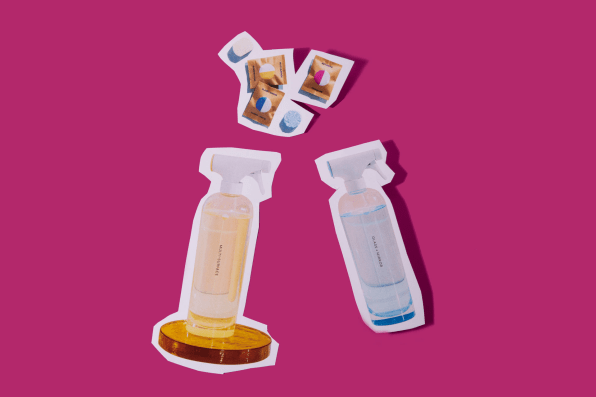
Try cleaning sprays that come in “forever bottles”
Soaps and sprays are vital to sanitizing, degreasing, and deodorizing your kitchen, but they generally come in plastic. Fortunately, a small group of startups is trying to make those bottles a thing of the past. Newly launched company Blueland created a system of household cleaning products that is easy to use and involves little waste, involving “forever bottles” with indestructible acrylic sprayers and cleaning tablets that dissolve in regular tap water. When you’ve used up all the spray, you refill with water and dissolve a new tablet, and you’re good to go. Blueland currently sells a set of three cleaning sprays (glass and mirror, bathroom, and multi-surface) for $29, and subsequent tablets cost $2 a pop. Plus, everything is delivered to your door.
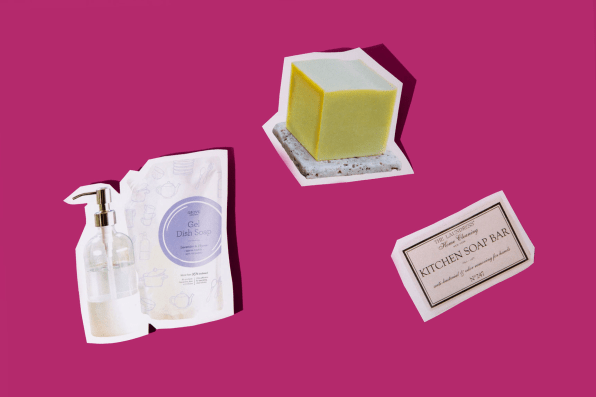
Use glass bottles for hand and dish soap
For other liquid soaps in your kitchen, you can cut down on your plastic considerably by buying durable, non-disposable bottles and refilling them. Full Circle Home offers bottles made from glass and bamboo for your foam or liquid hand soaps (and lotion, too). Grove Collaborative sells bottles with nonslip silicone bases that are specifically designed for dish soap. When you need to refill your bottles, Grove sells plastic pouches of hand and dish soap that use 60% less plastic than competitors’ bottles of the same size.
And if you want to take your dishwashing to the next level by eliminating the need for any plastic at all, you can use bar soaps for washing your dishes. The Laundress and Beehive Alchemy offer bars specifically designed to cut the grease on dishes.
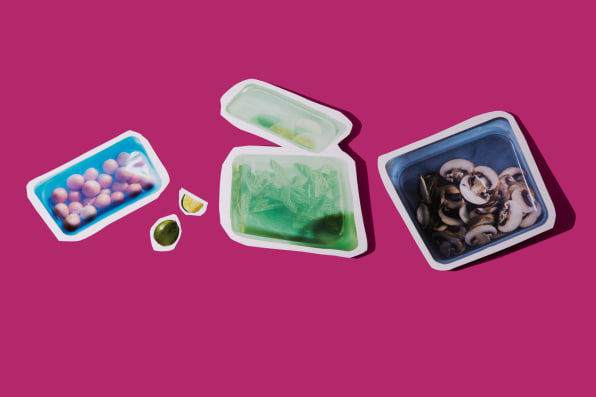
Rethink baggies
Disposable plastic baggies—like those made by Ziploc and Hefty—were a game changer when they became popular in the 1970s, making it easy to store small portions of food and send kids to school with just enough carrot sticks for their lunch. But . . . they’re plastic and meant to be thrown out. My favorite alternative is Stasher, which makes sturdy, sealable bags from silicone, made from quartz rather than petroleum. Sizes are similar to the classic plastic ones: sandwich bags and gallon bags for the freezer. But the company has also created new shapes that provide even more functionality: pocket-size Stashers, for example, are great for snacks, while flat-bottomed ones can stand up, for easy filling and use. They’re dishwasher safe, freezer safe, and oven and microwave safe, so you can heat up food (or even popcorn) right in them. You can also bring them to the bulk aisle of the grocery store to cut down on the amount of plastic you bring home in the first place.
Ditch your plastic water filter system
If you like to drink filtered water, you may be using a plastic pitcher from a brand like Brita. Those pitchers are designed for extended usage, but they do need to be replaced periodically. If you’re looking for a less plastic-intensive alternative, opt for a tap filtration system, which can cost as little as $20. If you do want a vessel-based system, go for glass. Soma‘s $49 glass carafe pitcher is beautiful and uses filters that are 65% plant based and made from renewable materials. Soma also sells a $30 ceramic mug, a $30 glass water bottle, and a $40 glass brew bottle that has a filter on it for your coffee. It’s worth noting that these bottles and pitchers are slightly heavier than their plastic alternative—but they make up for it by being more elegant, durable, and sustainable.
No more soda bottles
A big source of waste in my home came from bottles of sparkling water. We noticeably cut down on our recyclables when we got a SodaStream. The company recently launched new carbonation systems that use $15 glass bottles, rather than plastic ones. These bottles are far more beautiful and durable, and they’re also better for the environment. If you’re into other soda beverages, you can purchase flavorings directly from SodaStream or other brands.
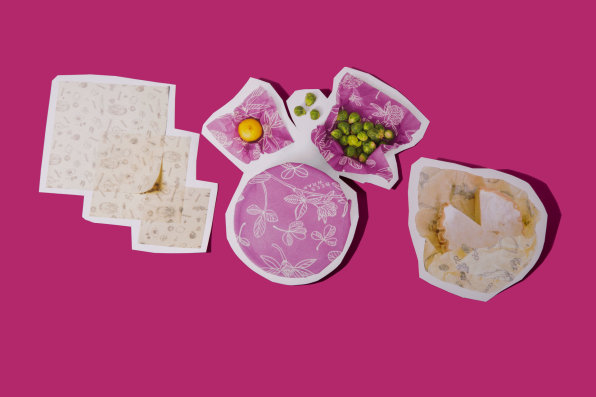
Forget plastic wrap
Plastic wrap was another wonder product that made food storage more convenient, but it also creates waste instantly. While there isn’t a sustainable product that does everything that plastic wrap does, beeswax-coated fabric accomplishes many of the same things. Abeego and Bee’s Wrap, for instance, create reusable sheets that you can use to cover cut fruit, vegetables, and bread. (A pack of three commonly used sizes costs $18 at both brands). These wraps cover bowls, too, though they’re not as sticky as plastic wrap. Beeswax-coated fabric has some advantages: Plastic doesn’t let air pass through it, so when you use plastic wrap to cover organic produce, it tends to accelerate rotting by trapping juices. Beeswax, on the other hand, is breathable, so produce tends to stay fresh longer. In theory, this could cut down on food waste. Plus, beeswax-coated fabric is designed to be washed (in cold water) and reused many times, and it will completely biodegrade when you’re done with it.
Get replaceable scrubbing brushes
Scouring greasy dishes is tough work, and most brands sell plastic brushes so that the customer can chuck it out when it gets too gross to keep using. To cut down on plastic waste, some eco-friendly brands have developed brushes made from sustainably-sourced bamboo with replaceable heads. Full Circle has created brushes for dishes and more delicate ones for glass and bottles. The brush heads stay firmly in place when you’re cleaning but slide out easily when you need to replace them.
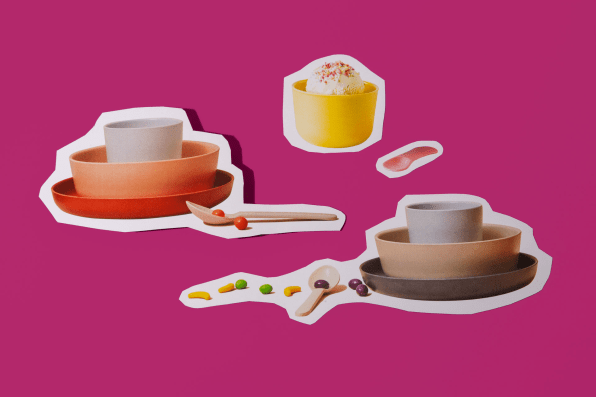
Introduce kids to sustainable dishware
If you have children, chances are you have at least one kitchen cabinet filled with cheap, plastic cups and dishes for your little ones. Plastic is useful for parents because it is virtually indestructible, but there are other alternatives. Instead of plastic cups, you can go for stainless steel tumblers. And brands like Ekobo have created unbreakable kids’ plates, bowls, cups, and forks from bamboo (which is biodegradable and carbon-negative to grow) that come in a wide range of bright colors. They’re dishwasher-safe, though they can’t be put in the microwave.

Switch to compostable trash bags
Skip the conventional garbage bag and go for one that is biodegradable. Be careful what you pick, though. Many brands, including Glad, create plastic bags that are certified compostable, but they need to be sprayed with chemicals before they will break down, and most waste management facilities are not equipped to take this step. Instead, go for brands like Biobag, which will naturally biodegrade since they can be consumed by microorganisms in our soil.
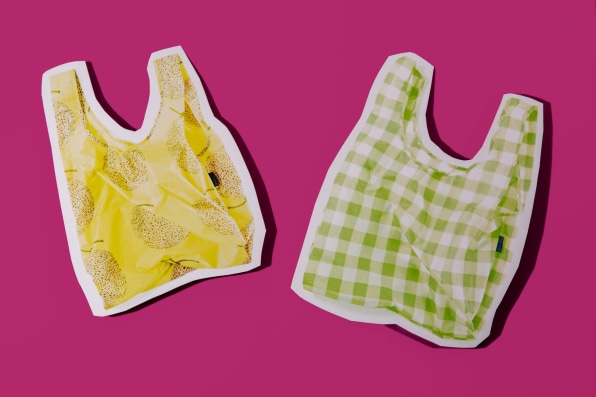
Stock up on the right kind of reusable grocery bag
It’s become more common for consumers to bring their own bags to the grocery store, thanks in part to some cities charging for them and some retailers offering a discount to people who bring one from home. But a recent study found that not all reusable bags are created equal. Cotton bags, for example, aren’t a great option because they require a lot of resources to manufacture, as do paper bags. A better alternative is a durable plastic bag that you will keep for years. I recommend Baggu, which makes lightweight totes in fun patterns that come in little pouches to make it easier to stash the bag away when you’re not using it.
Swapping out landfill-bound kitchen items for more sustainable, plastic-free ones isn’t particularly hard or expensive. And many of these alternative products are actually more effective and elegant, and therefore more enjoyable to use. The best part? Notice how much longer it takes for your trash and recycling bins to fill up. Every decision counts.
[Photos: courtesy of Blueland, grove Colaborative, The Launderess, Beehive Alchemy, Stashers, Abeego, Beeswrap, Ekobo, Biobag, and Baggu]
This story is part of Fast Company‘s special coverage of “The New Business of Food,” in which we explore how changes in culture, technology, and the environment are altering the food industry’s entire metabolism. Click here to read the whole series.
https://www.fastcompany.com/90366987/kitchen-makeover-fastcompany-guide-to-getting-rid-of-single-use-plastic
2019-07-24 13:30:00Z
CBMibGh0dHBzOi8vd3d3LmZhc3Rjb21wYW55LmNvbS85MDM2Njk4Ny9raXRjaGVuLW1ha2VvdmVyLWZhc3Rjb21wYW55LWd1aWRlLXRvLWdldHRpbmctcmlkLW9mLXNpbmdsZS11c2UtcGxhc3RpY9IBAA
Bagikan Berita Ini















0 Response to "Kitchen makeover - Fast Company"
Post a Comment